Building AAC Facilitation Skills with Tabi Jones-Wohleber: MASTER PAL Training, Module 1
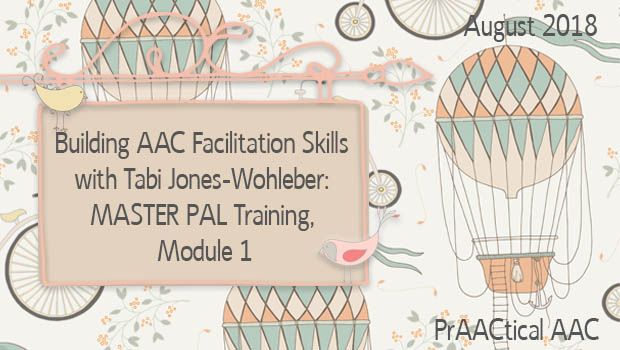
Are you…
- Hoping to train team members to be better communication partners for their AAC students/clients but overwhelmed by the thought of all the preparation?
- Relatively new to AAC and not sure what content to share in your training?
- Looking for additional resources to utilize in your existing training sessions?
Good news, AAC friends! This post is for you.
We’re so happy to have SLP Tabi Jones-Wohleber returning to the blog to share more of her wonderful AAC resources. Tabi works with young children at the West Virginia Birth to Three program and serves on the AT Team for Frederick County Public Schools in Maryland. Today, she launches a new series on partner training that focuses on the use of aided language input and other facilitative strategies.
There are 11 modules in all (1 overview for administrative discussions and 10 for communication partners) and each one includes slides, handouts, discussion prompts, links to videos, and activity suggestions. Fasten your seatbelts – there’s a lot to cover.
Enjoy!
:::::::::::::::::::::::::::::::::::::::::::::::::::::::::::
Despite tons of support on core vocabulary, which everyone “gets” on some level, there is a real need for ongoing support of communication partners to look at the actual nature of the interactions (which tend to look more like compliance than communication). This is the first of 11 posts sharing resources for ‘Model as a MASTER PAL’ partner training.
Let’s get started!
Congratulations on Presenting Model as a MASTER PAL!
‘Model as a MASTER PAL’ was developed to help shape behaviors and belief systems of communication partners supporting individuals who use AAC. It was developed from the premise that 1) AAC implementation is not intuitive, and 2) communication is not compliance. This training series assumes topics related to core vocabulary instruction and explicit creation of communication opportunities have already been covered, and communication partners require additional information to improve the effectiveness of implementation. The structure of this training series lends itself to delivery over time for ongoing discussion and support related to AAC implementation. It emphasizes that modeling language with AAC is the communication partners responsibility (full stop)!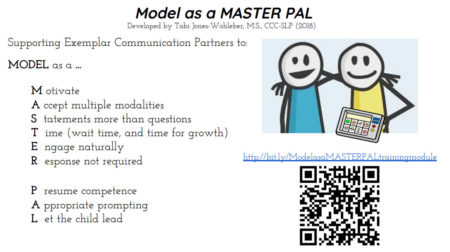
The training module topics include:
- Overview of ‘Model as a MASTER PAL’ (to share with directors and other stakeholders to provide information about the importance of providing effective and ongoing support for communication partners of individuals who use AAC.)
- Modeling, an Overview
- Motivate
- Accept Multiple Modalities
- Statements more than Questions
- Time (wait time and time for language to develop)
- Engage Naturally
- Response NOT Required
- Presume Competence
- Appropriate Prompting
- Let the Child Lead
This training module contains facilitator notes, Google slides, and resources to guide you through the process. Each training module has a parallel structure with Facilitator Guidelines that you should print. It includes the following:
-
- Handout- link to PDF of Google Presentation for participants
- Warm up discussion – Thinking Prompts and Making Connections/Talking Points
- The Discourse – Topics, Slides, & Talking Points/Examples
- Supplemental Handouts
- Video Links
- Interactive Activities/Discussion
- Extension Resources
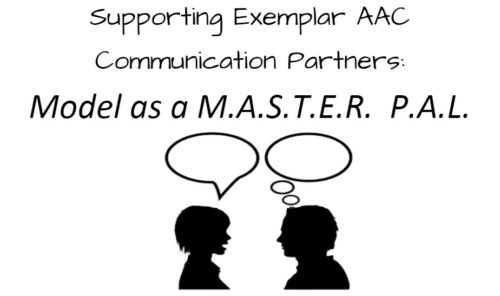 Training Modules
Training Modules
- Begin with a definition of the ‘Model as a MASTER PAL’ acronym and an overview of AAC as participants may fluctuate from session to session and this helps to ensure that everyone is on the same page.
- The Warm Up Discussion follows. Slide fonts are green and italicized to cue you to engage participants.
- As you go through the body of the presentation, the Talking Points for a slide or group of slides is outlined in your Facilitator Guidelines. This gives you an understanding of the thought behind the slides to help you lead the discussion.
- A Re-cap reviews the key-points/takeaways and provides a consistent finishing point.
- Each module ends with a time for Comments and Questions.
Additional resources in each module include:
- Google Slide Handouts-link to PDF of Google Presentation for participants
- Supplemental Handouts- PDFs of additional information related to module topics (numbered corresponding to module topic number)
**The sharing settings for all documents in this training module are set to “public” with rights to “view”
Tips:
- To modify or edit Google Slide(s), copy/paste the entire Google Slide and create a new document in your Google Drive.
- To hide slides when in presentation mode, right-click on a slide and select “skip slide”
You can download a document with these Trainer Guidelines here.
:::::::::::::::::::::::::::::::::::::::::::::::::::::::::::::::::::::::::::::::::
Ready to get started? Here’s what you’ll need.
- Module 1 Facilitator Guide
- Slide Deck for Module 1
- Participant Handouts (from slides)
- Supplemental Resources
- Top Tips for Implementing AAC
- NJC Communication Bill of Rights
- Communication Bill of Rights Graphic by Kate Ahern [PCS]
- AAC Agreements – Chris Chichoski Kelly/2018 ATIA Conference
- Model as a MASTER PAL Poster
We’re just getting warmed up! Come back next week for the second module in this series.
Filed under: Featured Posts, PrAACtical Thinking
Tagged With: AAC partner training, inservice, Tabi Jones-Wohleber, Training
This post was written by Carole Zangari

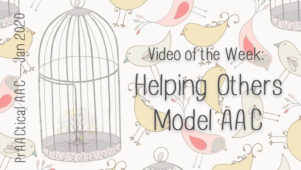
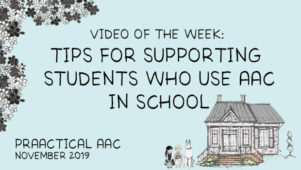

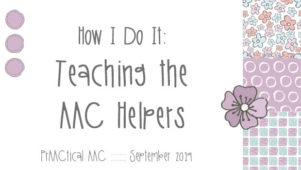
13 Comments
So excited to see this! I just heard your Talking With Tech podcast and thought it was great. Thank you for sharing so much of your work!
I’m so glad you enjoyed it, and am happy to share. We are a hard-working field…no need to reinvent the wheel!!!
Love this idea! Exactly what my school district needs. To piggy back on core vocabulary….has anyone tried to identify core vocabulary throughout a school or home? For instance, at the water fountain, core words would include: more, stop, drink, want, I, like, etc. Didn’t know if there were any resources out there that people were using!
I would love to see examples of core vocabulary by context! I bet lots of us do this in informally and in-the-moment. I don’t know of anything systematic, but I like the idea!!
Love this! I will be training my staff with this throughout the year!
Thank you for taking the time to put this all together and share it! What a great resource! Can’t wait to see it all!
Hope you enjoy it, Judy. Tabi certainly did an amazing job in developing these resources, didn’t she?! The last module in this 11-part training series will be published later this week. Stay tuned!
My AT Team had a goal of putting together a para-educator training program just like this and you have done it for us! This is an amazing and beautiful resource! Thank you so much! I will be singing your praises at each meeting!!
Fantastic. So glad these tools will help you pursue that goal. Training para-educators is important work. Our kiddos need them to have access to this information and the opportunity for discussion on these topics. Kudos!
I love these trainings, and I have 2 hours during my school’s in-service next week to do some AAC training. Is there anywhere that gives an idea about how long each module/section would take to present?
Yes! In the master folder there is a sub-folder titled “Start Here”. In it there is a document called “Planning for Model as a MASTER PAL.” It gives an estimated time if all slides and activities are used as well as links to all documents. This can help you edit as needed for the time you have.
Hope that helps
Thank you, that does help! I can’t find the master folder, though. Is it the AAC tool box? I looked under there and didn’t find anything about master pal. Thanks
I’m all about reinventing the wheel. I saved all these resources and shared them with the other AT TaCs I work with. Thank you!